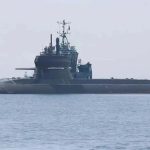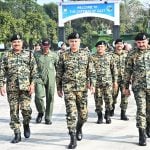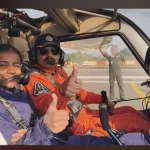On Independence Day 2025, President Droupadi Murmu conferred the Vir Chakra, India’s third-highest wartime gallantry award, on Group Captain Animesh Patni for his extraordinary role in Operation Sindoor.
Patni commanded the S-400 air defence regiment that achieved the world’s longest-ever confirmed surface-to-air missile kill at 314 kilometers, downing a Pakistani aircraft deep inside enemy territory. This achievement not only showcased India’s unmatched air defence capability but also redefined the dynamics of aerial warfare in South Asia.
Who is Group Captain Animesh Patni?
Roots in Rajasthan
Group Captain Patni hails from Kunjed village in Baran district, Rajasthan. His recognition has brought immense pride to the region, placing Baran firmly on India’s defence map.
Military Career
Commissioned into the Indian Air Force on December 17, 2005 as part of the 176th Course, a career fighter pilot with extensive experience on the MiG-29, was specially chosen to command India’s advanced S-400 ‘Triumf’ air defence system.
His career reflects the journey of a young flight cadet rising through grit, technology mastery, and leadership to command the most advanced missile defence system in India.
Operation Sindoor: The Context
Trigger for Action
Operation Sindoor was India’s military response to the April 22, 2025 Pahalgam terrorist attack, where 26 tourists were killed by Pakistan-backed groups. The attack, claimed by The Resistance Front (TRF), compelled New Delhi to act decisively.
The Operation
Launched on May 7, 2025, Operation Sindoor was a 23-minute precision strike campaign targeting nine terror camps in Pakistan and Pakistan-occupied Kashmir. Unlike previous limited operations, this mission carried full political backing and zero restrictions, giving the Indian Air Force complete freedom to act.
Objectives included:
- Destroying terrorist infrastructure without harming civilians.
- Demonstrating long-range precision strike and air defence dominance.
- Delivering a strategic deterrent message to Pakistan and China.
The Historic 314 km Kill
A Global Record
During the operation, India’s S-400 system shot down a Pakistani Saab 2000 AEW&C aircraft (Airborne Early Warning & Control) at a range of 314 kilometers.
Air Chief Marshal A.P. Singh described it as “the largest-ever recorded surface-to-air kill we can talk about”. Military analyst Tom Cooper called it “the longest confirmed SAM kill in history”, surpassing the 200 km record from the Russia-Ukraine war.
Precision and Risk
The engagement demanded:
- Long-range radar tracking across 300+ km.
- Missile guidance accuracy under contested electronic warfare.
- Split-second decision-making to hit a high-value, fast-moving target.
- Deployment of the S-400 near the border, making it vulnerable to Pakistani artillery fire.
Despite these risks, Group Captain Patni’s leadership ensured flawless execution.
The S-400 “Sudarshan Chakra”: India’s Game-Changer
India’s ₹39,000 crore S-400 Triumf system, procured from Russia, proved decisive in Operation Sindoor.
Missile Arsenal:
- 40N6 missiles – 400 km range.
- 48N6DM missiles – 250 km range.
- 9M96E2 missiles – 120 km range.
- 9M96E missiles – 40 km range.
Radar Capabilities:
- 91N6E ‘Big Bird’ radar – detects targets at 600 km.
- 92N6E ‘Grave Stone’ radar – fire-control radar engaging 36 targets simultaneously.
Operational Results:
- Engaged 16–18 targets, including drones, fighters, and precision-guided weapons.
- Downed five Pakistani fighter jets in addition to the AEW&C aircraft.
- Intercepted Pakistan’s H-2 and H-4 glide bombs mid-air.
Air Chief Marshal Singh summed it up: “The S-400 was a game-changer for us.”
Significance of the Achievement
Tactical Impact
- Neutralized Pakistan’s airborne surveillance capability.
- Protected Indian bases through area denial.
- Prevented Pakistani Air Force from mounting counter-strikes.
Strategic Messaging
- To Pakistan: India can strike deep into its airspace.
- To China & Region: India has credible long-range precision strike ability.
- To the World: India uses power with restraint, hitting terror camps while sparing civilians.
Technological Validation
India’s decision to procure the S-400 despite US CAATSA sanctions pressure was vindicated by this historic success.
The Vir Chakra Recognition
The Vir Chakra, instituted in 1950, is India’s third-highest wartime gallantry award. Group Captain Patni’s award is particularly rare for an air defence officer, as most recipients are fighter pilots or ground troops.
His recognition reflects:
- Exceptional leadership under combat pressure.
- Tactical brilliance in achieving a record-breaking kill.
- Courage in high-risk deployment zones.
Rajasthan’s Pride and Family Honour
Patni’s award brought immense pride to Baran district and Kunjed village. His brother, Advocate Prashant Patni, revealed that Prime Minister Narendra Modi personally visited Adampur Air Base to congratulate him.
His recognition has already begun inspiring Rajasthan’s youth to pursue careers in the armed forces.
Operation Sindoor: Overall Outcomes
- Destroyed terror camps in Muridke and Bahawalpur.
- Neutralized six Pakistani radars and damaged airbases.
- Shot down six Pakistani aircraft (including AEW&C and fighter jets).
- Foiled multiple drone and missile attacks on Indian territory.
International analysts confirmed India’s success. John Spencer and Vincent Viola termed it a “strategic turning point,” while satellite data confirmed damage to Pakistan’s air bases.
Legacy and Future Implications
Group Captain Patni’s success will reshape Indian military doctrine:
- Long-range SAM engagements become central to defence strategy.
- Recognition of air defence commanders as pivotal warfighters.
- Greater emphasis on S-400 training and integration with indigenous systems.
Above all, it strengthens India’s deterrence posture, signaling that terrorist attacks will invite swift, overwhelming responses.
Conclusion
From a village in Rajasthan to commanding India’s most advanced missile shield, Group Captain Animesh Patni has written history. His leadership during Operation Sindoor led to the world’s longest-ever air defence kill at 314 km, cementing India’s reputation as a modern military power.
The Vir Chakra awarded to him is more than an individual honour — it symbolizes India’s technological leap, strategic resolve, and the courage of its air warriors.
Patni’s story is a testament to the Indian Air Force’s evolution: from Kargil’s dogfights to today’s long-range precision dominance. His legacy will inspire future generations to serve, innovate, and protect India’s skies with the same determination.













